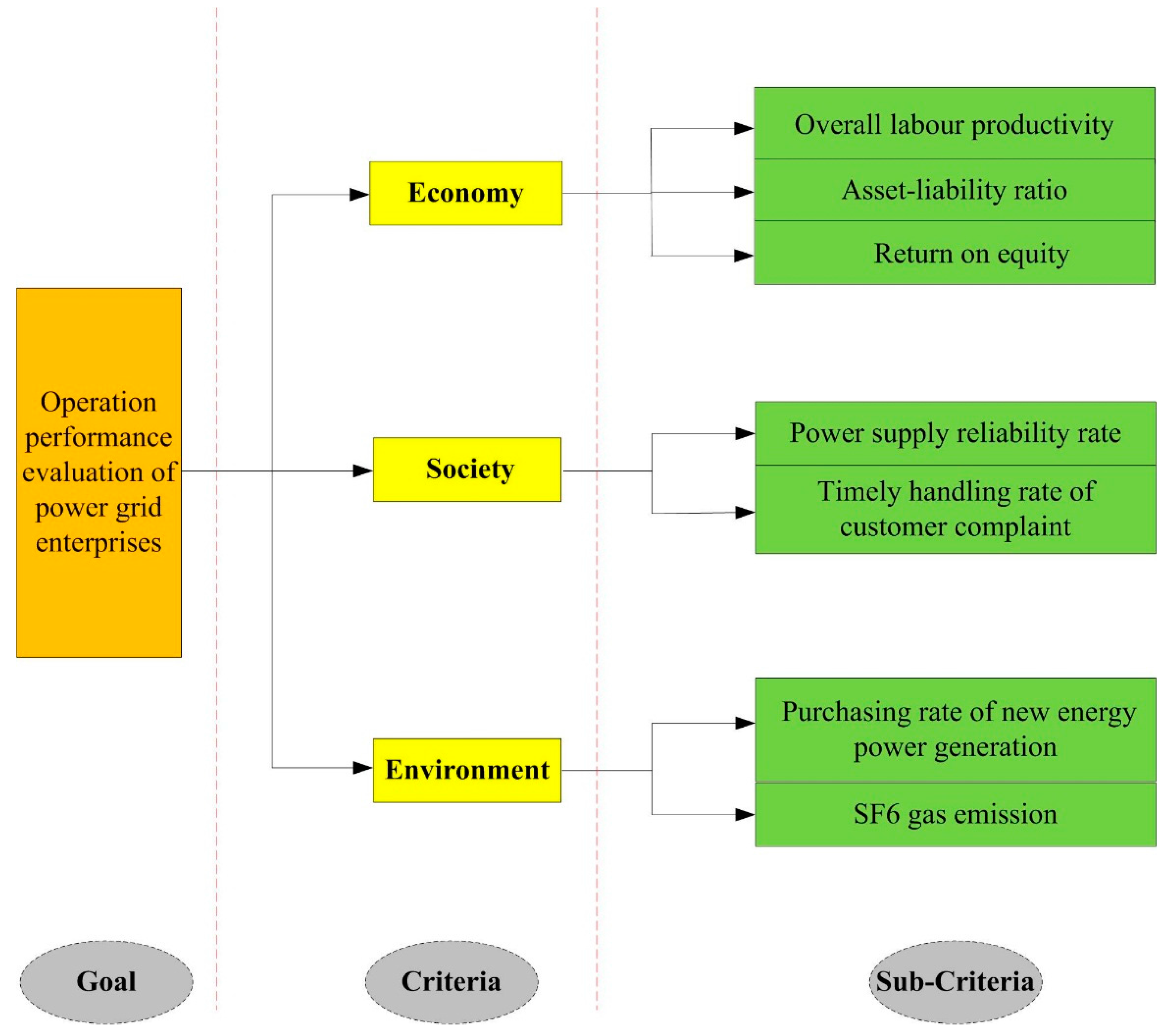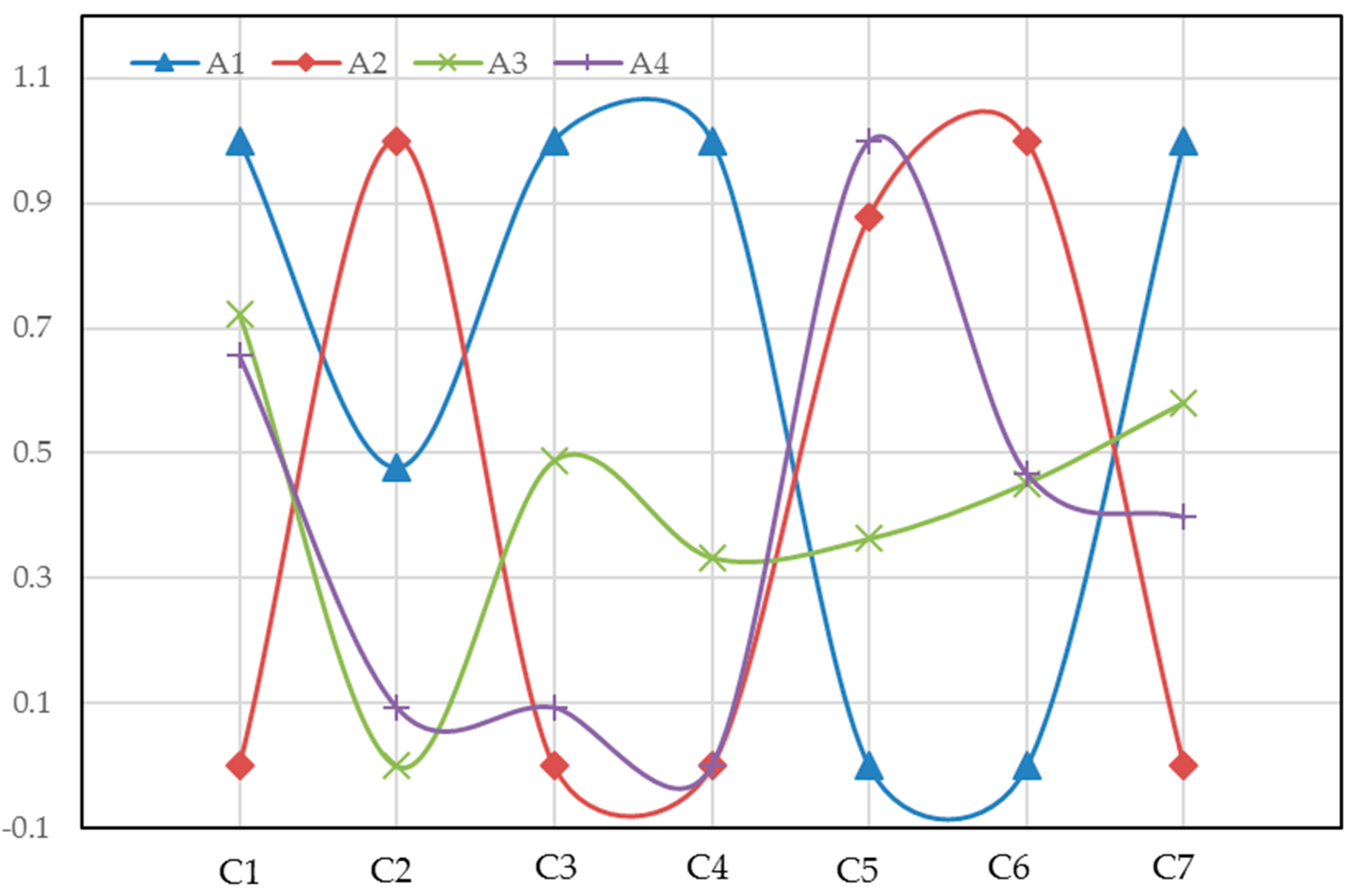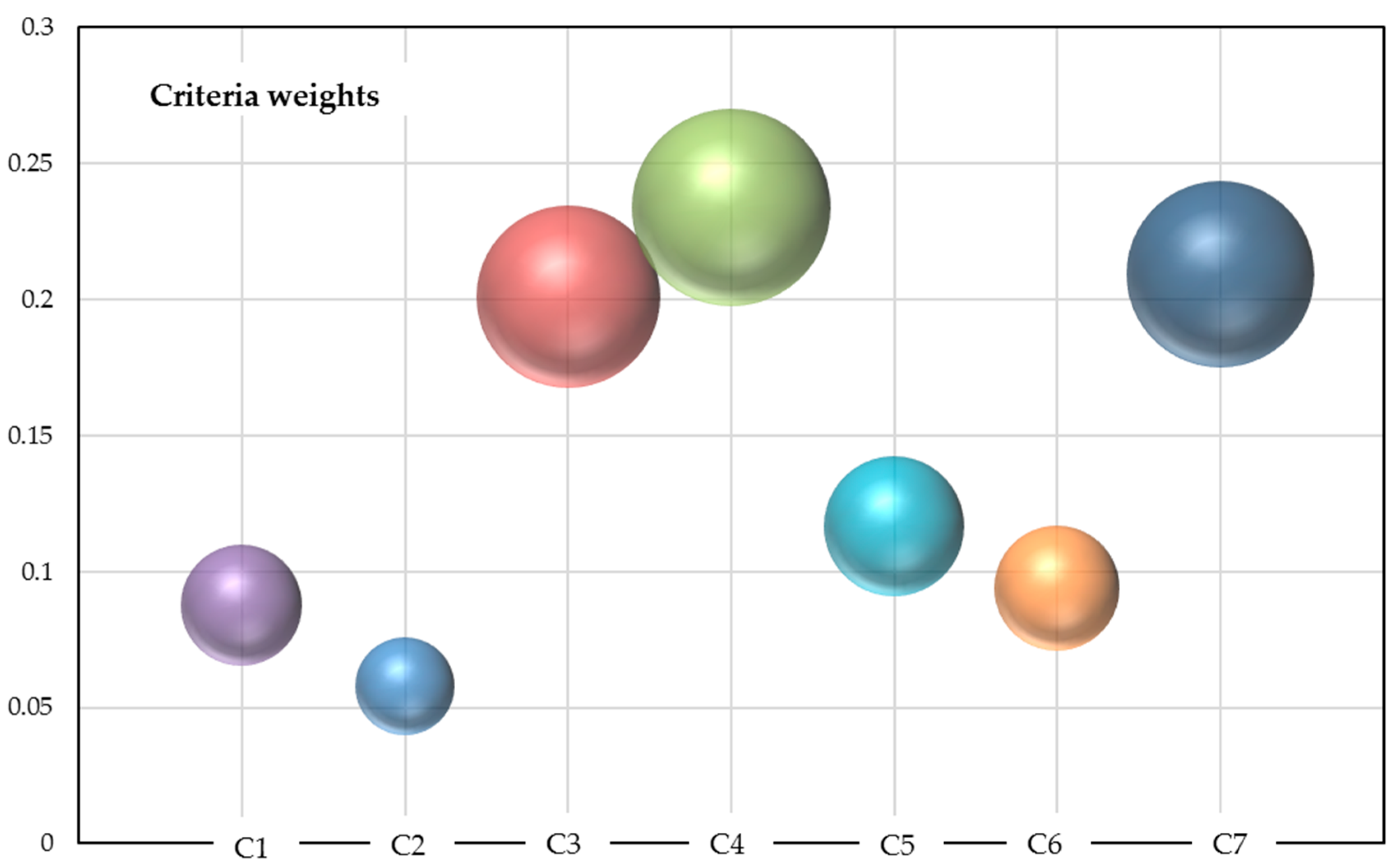Operation Performance Evaluation of Power Grid Enterprise Using a Hybrid BWM-TOPSIS Method
Abstract
:1. Introduction
2. Basic Theories of BWM and TOPSIS Methods
2.1. BWM for Criteria Weight Determination
2.2. TOPSIS Method for Operational Performance Ranking of a Power Grid Enterprise
3. Evaluation Index System for Operation Performance of Power Grid Enterprises
3.1. Economic Criterion
- (1)
- Overall labor productivity (C1) measures the electrical energy production per capita in a certain period of time, which is an important indicator for evaluating the economic activity of a power grid enterprise. High overall labor productivity indicates the high production technology and business management level of the power grid enterprise. Meanwhile, this sub-criterion can also represent the enthusiasm and economic contribution of labor.
- (2)
- Asset-liability ratio (C2) can be calculated by the total liabilities divided by the total assets, which is an indicator for evaluating the liabilities level of a power grid enterprise and evaluating the degree of protecting creditor’s interests. A low asset-liability ratio indicates the high economic management capacity of creditors and the corresponding high interest guarantee degree. Meanwhile, this sub-criterion can also reflect the financial risk of a power grid enterprise, which will indirectly impact the economic benefit of the power grid enterprise.
- (3)
- Return on equity (C3) is the ratio of retained profits to average owner’s equity, which represents the profit level of stockholders’ equity and reflects the efficiency of owned capital operated by the power grid enterprise. A high return on equity indicates high gains on investment and high net earning capacity of owned capital of the power grid enterprise.
3.2. Social Criterion
- (1)
- Power supply reliability rate (C4) is an important indicator to evaluate power supply quality, which can be calculated by: (1 − average interruption hours of the customer/8760) × 100%. With a high penetration of renewable energy power with the characteristics of volatility and intermittency, the power grid will suffer influences and then induce an unstable power supply. A low power supply reliability rate will damage production equipment of the enterprise and household appliances, which will impact the enterprise’s normal production, and residents’ living and social stability.
- (2)
- Timely handling rate of customer complaint (C5) is the handled customer complaints divided by the total customer complaints in a certain period of time, which reflects the service quality of the power grid enterprise. A high timely handling rate of customer complaints indicates that a majority of customer complaints can be handled in a timely manner and be effectively solved. This will reduce the financial loss of customers and improve the degree of customer loyalty. With the increasing emersions of electricity-selling enterprises, the improvement of the degree of customer loyalty is quite important, which will keep, and even increase, the electricity-selling market share of the power grid enterprise.
3.3. Environmental Criterion
- (1)
- Purchasing rate of new energy power generation (C6) is the ratio of total purchased new energy power generation to the total purchased power generation (mainly including thermal power generation, hydroelectric generation, and new energy power generation). The new energy power includes several power types, such as wind power, solar photovoltaic power, and biomass power, which hold the characteristic of less emission pollution (such as CO2 and SO2). Purchasing new energy power generation will substitute for fossil fuels-based power generation, which will reduce emission pollution and protect the environment.
- (2)
- SF6 gas emission (C7): SF6 gas is a kind of greenhouse gas that is mainly consumed by electrical equipment, such as circuit breakers, high-voltage transformers, instrument transformers, and high-voltage transmission lines. SF6 gas is a kind of extremely stable gas, and its lifetime in the atmosphere is about 3200 years. SF6 gas has a strong capacity of absorbing infrared radiation, which indicates it is a kind of greenhouse gas. Currently, the SF6 gas emitted into the atmosphere is growing in China, which should be paid more attention. In this paper, the SF6 gas emission can be obtained according to the statistical accounting of the power grid enterprise in units of kilogram.
4. Empirical Analysis
4.1. Determine the Weights of Criteria Using BWM
4.2. Build the Initial Decision Matrix
4.3. Calculate the Normalized Decision Matrix
4.4. Construct the Weighted Normalized Decision Matrix
4.5. Determine the Positive Ideal Solution and the Negative Ideal Solution
4.6. Calculate the Distances of Four Power Grid Enterprises from the Positive and Negative Ideal Solution
4.7. Calculate the Closeness Coefficients of Four Power Grid Enterprises and Rank
5. Conclusions
Acknowledgments
Author Contributions
Conflicts of Interest
References
- Sun, W.; Xu, Y. Financial security evaluation of the electric power industry in China based on a back propagation neural network optimized by genetic algorithm. Energy 2016, 101, 366–379. [Google Scholar] [CrossRef]
- Zhao, H.; Guo, S.; Zhang, Q.; Li, C. Social Welfare Evaluation of Electric Universal Service in China: From the Perspective of Sustainability. Sustainability 2014, 6, 4949–4965. [Google Scholar] [CrossRef]
- Tang, Y.; Cao, J.; Guo, C.; Cao, Y.; Han, Z. Research and Implementation of Power Grid Enterprise Application Integration Based on Services-oriented Architecture. Autom. Electr. Power Syst. 2008, 32, 50–54. [Google Scholar]
- Meng, Y.-T.; Wu, J.-F.; Wang, F. Study on Reform of Cost Management and Control for Power Grid Enterprise. Electr. Power Technol. Econ. 2006, 2, 62–65. [Google Scholar]
- Guo, S.; Zhao, H.; Zhao, H. The Most Economical Mode of Power Supply for Remote and Less Developed Areas in China: Power Grid Extension or Micro-Grid? Sustainability 2017, 9, 910. [Google Scholar] [CrossRef]
- Bo, Z.; Shaojie, O.; Jianhua, Z.; Hui, S.; Geng, W.; Ming, Z. An analysis of previous blackouts in the world: Lessons for China’ s power industry. Renew. Sustain. Energy Rev. 2015, 42, 1151–1163. [Google Scholar] [CrossRef]
- Zheng, Y.; Hu, Z.; Wang, J.; Wen, Q. IRSP (integrated resource strategic planning) with interconnected smart grids in integrating renewable energy and implementing DSM (demand side management) in China. Energy 2014, 76, 863–874. [Google Scholar] [CrossRef]
- Shen, J.; Luo, C. Overall review of renewable energy subsidy policies in China—Contradictions of intentions and effects. Renew. Sustain. Energy Rev. 2015, 41, 1478–1488. [Google Scholar] [CrossRef]
- Zhao, H.-R.; Guo, S.; Fu, L.-W. Review on the costs and benefits of renewable energy power subsidy in China. Renew. Sustain. Energy Rev. 2014, 37, 538–549. [Google Scholar] [CrossRef]
- Zhou, K.; Yang, S. Demand side management in China: The context of China’s power industry reform. Renew. Sustain. Energy Rev. 2015, 47, 954–965. [Google Scholar] [CrossRef]
- Zeng, M.; Yang, Y.; Wang, L.; Sun, J. The power industry reform in China 2015: Policies, evaluations and solutions. Renew. Sustain. Energy Rev. 2016, 57, 94–110. [Google Scholar] [CrossRef]
- Zhang, S.; Jiao, Y.; Chen, W. Demand-side management (DSM) in the context of China’s on-going power sector reform. Energy Policy 2017, 100, 1–8. [Google Scholar] [CrossRef]
- Yu, D.; Qiu, H.; Yuan, X.; Li, Y.; Shao, C.; Lin, Y.; Ding, Y. Roadmap of Retail Electricity Market Reform in China: Assisting in Mitigating Wind Energy Curtailment; IOP Conference Series: Earth and Environmental Science; IOP Publishing: Bristol, UK, 2017; p. 012031. [Google Scholar]
- Dong, J.; Huo, H.; Guo, S. Demand Side Management Performance Evaluation for Commercial Enterprises. Sustainability 2016, 8, 1041. [Google Scholar] [CrossRef]
- Guo, S.; Zhao, H. Optimal site selection of electric vehicle charging station by using fuzzy TOPSIS based on sustainability perspective. Appl. Energy 2015, 158, 390–402. [Google Scholar] [CrossRef]
- Yoon, K.P.; Hwang, C.-L. Multiple Attribute Decision Making: An Introduction; Sage Publications: Thousand Oaks, CA, USA, 1995; Volume 104. [Google Scholar]
- Brans, J.-P.; Vincke, P. Note—A Preference Ranking Organisation Method (The PROMETHEE Method for Multiple Criteria Decision-Making). Manag. Sci. 1985, 31, 647–656. [Google Scholar] [CrossRef]
- Opricovic, S. Multicriteria Optimization of Civil Engineering Systems. Ph.D. Thesis, Faculty of Civil Engineering, University of Belgrade, Belgrade, Serbia, 1998. [Google Scholar]
- Maystre, L.Y.; Pictet, J.; Simos, J. Méthodes Multicritères ELECTRE: Description, Conseils Pratiques et Cas D’application à la Gestion Environnementale; PPUR Presses Polytechniques: Lausanne, Switzerland, 1994; Volume 8. [Google Scholar]
- Saaty, T.L. What is the analytic hierarchy process? In Mathematical Models for Decision Support; Springer: Berlin/Heidelberg, Germany, 1988; pp. 109–121. [Google Scholar]
- Dai, S.; Niu, D. Comprehensive Evaluation of the Sustainable Development of Power Grid Enterprises Based on the Model of Fuzzy Group Ideal Point Method and Combination Weighting Method with Improved Group Order Relation Method and Entropy Weight Method. Sustainability 2017, 9, 1900. [Google Scholar]
- Wang, Q.; Dai, H.-N.; Wang, H. A Smart MCDM Framework to Evaluate the Impact of Air Pollution on City Sustainability: A Case Study from China. Sustainability 2017, 9, 911. [Google Scholar] [CrossRef]
- Zhao, H.; Guo, S. Selecting green supplier of thermal power equipment by using a hybrid MCDM method for sustainability. Sustainability 2014, 6, 217–235. [Google Scholar] [CrossRef]
- Zavadskas, E.K.; Cavallaro, F.; Podvezko, V.; Ubarte, I.; Kaklauskas, A. MCDM Assessment of a Healthy and Safe Built Environment According to Sustainable Development Principles: A Practical Neighborhood Approach in Vilnius. Sustainability 2017, 9, 702. [Google Scholar] [CrossRef]
- Chung, E.-S.; Abdulai, P.J.; Park, H.; Kim, Y.; Ahn, S.R.; Kim, S.J. Multi-criteria assessment of spatial robust water resource vulnerability using the TOPSIS method coupled with objective and subjective weights in the Han River basin. Sustainability 2016, 9, 29. [Google Scholar] [CrossRef]
- Lu, C.; Xue, B.; Lu, C.; Wang, T.; Jiang, L.; Zhang, Z.; Ren, W. Sustainability Investigation of Resource-Based Cities in Northeastern China. Sustainability 2016, 8, 1058. [Google Scholar] [CrossRef]
- Seçme, N.Y.; Bayrakdaroğlu, A.; Kahraman, C. Fuzzy performance evaluation in Turkish banking sector using analytic hierarchy process and TOPSIS. Expert Syst. Appl. 2009, 36, 11699–11709. [Google Scholar] [CrossRef]
- Xu, J.; Jiang, X.; Wu, Z. A Sustainable Performance Assessment Framework for Plastic Film Supply Chain Management from a Chinese Perspective. Sustainability 2016, 8, 1042. [Google Scholar] [CrossRef]
- Chang, Y.H.; Shao, P.C.; Chen, H.J. Performance evaluation of airport safety management systems in Taiwan. Saf. Sci. 2015, 75, 72–86. [Google Scholar] [CrossRef]
- Zhao, H.; Li, N. Performance evaluation for sustainability of strong smart grid by using stochastic AHP and fuzzy TOPSIS methods. Sustainability 2016, 8, 129. [Google Scholar] [CrossRef]
- Rezaei, J. Best-worst multi-criteria decision-making method. Omega 2015, 53, 49–57. [Google Scholar] [CrossRef]
- Rezaei, J. Best-worst multi-criteria decision-making method: Some properties and a linear model. Omega 2016, 64, 126–130. [Google Scholar] [CrossRef]
- Rezaei, J.; Nispeling, T.; Sarkis, J.; Tavasszy, L. A supplier selection life cycle approach integrating traditional and environmental criteria using the best worst method. J. Clean. Prod. 2016, 135, 577–588. [Google Scholar] [CrossRef]
- Hafezalkotob, A.; Hafezalkotob, A. A novel approach for combination of individual and group decisions based on fuzzy best-worst method. Appl. Soft Comput. 2017, 59, 316–325. [Google Scholar] [CrossRef]
- Ren, J.; Liang, H.; Chan, F.T. Urban sewage sludge, sustainability, and transition for Eco-City: Multi-criteria sustainability assessment of technologies based on best-worst method. Technol. Forecast. Soc. Chang. 2017, 116, 29–39. [Google Scholar] [CrossRef]
- Guo, S.; Zhao, H. Fuzzy best-worst multi-criteria decision-making method and its applications. Knowl. Based Syst. 2017, 121, 23–31. [Google Scholar] [CrossRef]
- Ahmadi, H.B.; Kusi-Sarpong, S.; Rezaei, J. Assessing the social sustainability of supply chains using Best Worst Method. Resour. Conserv. Recycl. 2017, 126, 99–106. [Google Scholar] [CrossRef]
- Chitsaz, N.; Azarnivand, A. Water scarcity management in arid regions based on an extended multiple criteria technique. Water Resour. Manag. 2017, 31, 233–250. [Google Scholar] [CrossRef]
- Gupta, H. Evaluating service quality of airline industry using hybrid best worst method and VIKOR. J. Air Transp. Manag. 2017, in press. [Google Scholar] [CrossRef]
- Salimi, N.; Rezaei, J. Measuring efficiency of university-industry Ph.D. projects using best worst method. Scientometrics 2016, 109, 1911–1938. [Google Scholar] [CrossRef] [PubMed]
- Salimi, N.; Rezaei, J. Evaluating firms’ R&D performance using best worst method. Eval. Program Plan. 2018, 66, 147–155. [Google Scholar]
- Wang, E. Benchmarking whole-building energy performance with multi-criteria technique for order preference by similarity to ideal solution using a selective objective-weighting approach. Appl. Energy 2015, 146, 92–103. [Google Scholar] [CrossRef]
- Hwang, C.-L.; Lai, Y.-J.; Liu, T.-Y. A new approach for multiple objective decision making. Comput. Oper. Res. 1993, 20, 889–899. [Google Scholar] [CrossRef]



| 1 | 2 | 3 | 4 | 5 | 6 | 7 | 8 | 9 | |
|---|---|---|---|---|---|---|---|---|---|
| CI | 0.00 | 0.44 | 1.00 | 1.63 | 2.30 | 3.00 | 3.73 | 4.47 | 5.23 |
| Criteria | Sub-Criteria | A1 | A2 | A3 | A4 |
|---|---|---|---|---|---|
| Economy | Overall labor productivity (C1) | 5989 | 5703 | 5910 | 5891 |
| Asset-liability ratio (C2) | 62.28 | 63.91 | 60.79 | 61.08 | |
| Return on equity (C3) | 18.01 | 17.58 | 17.79 | 17.62 | |
| Society | Power supply reliability rate (C4) | 99.98 | 99.95 | 99.96 | 99.95 |
| Timely handling rate of customer complaint (C5) | 98.23 | 98.52 | 98.35 | 98.56 | |
| Environment | Purchasing rate of new energy power generation (C6) | 5.04 | 9.13 | 6.89 | 6.95 |
| SF6 gas emission (C7) | 3150 | 1255 | 2357 | 2009 |
| DM1 | C1 | C2 | C3 | C4 | C5 | C6 | C7 |
| Best criterion: C3 | 3 | 5 | 1 | 2 | 4 | 7 | 3 |
| DM2 | C1 | C2 | C3 | C4 | C5 | C6 | C7 |
| Best criterion: C4 | 4 | 8 | 2 | 1 | 3 | 5 | 2 |
| DM3 | C1 | C2 | C3 | C4 | C5 | C6 | C7 |
| Best criterion: C7 | 9 | 6 | 5 | 3 | 4 | 3 | 1 |
| DM1 | Worst Criterion: C6 | DM2 | Worst Criterion: C2 | DM3 | Worst Criterion: C1 |
|---|---|---|---|---|---|
| C1 | 3 | C1 | 3 | C1 | 1 |
| C2 | 2 | C2 | 1 | C2 | 2 |
| C3 | 7 | C3 | 5 | C3 | 3 |
| C4 | 5 | C4 | 8 | C4 | 5 |
| C5 | 3 | C5 | 5 | C5 | 4 |
| C6 | 1 | C6 | 3 | C6 | 5 |
| C7 | 3 | C7 | 6 | C7 | 9 |
© 2017 by the authors. Licensee MDPI, Basel, Switzerland. This article is an open access article distributed under the terms and conditions of the Creative Commons Attribution (CC BY) license (http://creativecommons.org/licenses/by/4.0/).
Share and Cite
You, P.; Guo, S.; Zhao, H.; Zhao, H. Operation Performance Evaluation of Power Grid Enterprise Using a Hybrid BWM-TOPSIS Method. Sustainability 2017, 9, 2329. https://doi.org/10.3390/su9122329
You P, Guo S, Zhao H, Zhao H. Operation Performance Evaluation of Power Grid Enterprise Using a Hybrid BWM-TOPSIS Method. Sustainability. 2017; 9(12):2329. https://doi.org/10.3390/su9122329
Chicago/Turabian StyleYou, Peipei, Sen Guo, Haoran Zhao, and Huiru Zhao. 2017. "Operation Performance Evaluation of Power Grid Enterprise Using a Hybrid BWM-TOPSIS Method" Sustainability 9, no. 12: 2329. https://doi.org/10.3390/su9122329
APA StyleYou, P., Guo, S., Zhao, H., & Zhao, H. (2017). Operation Performance Evaluation of Power Grid Enterprise Using a Hybrid BWM-TOPSIS Method. Sustainability, 9(12), 2329. https://doi.org/10.3390/su9122329




